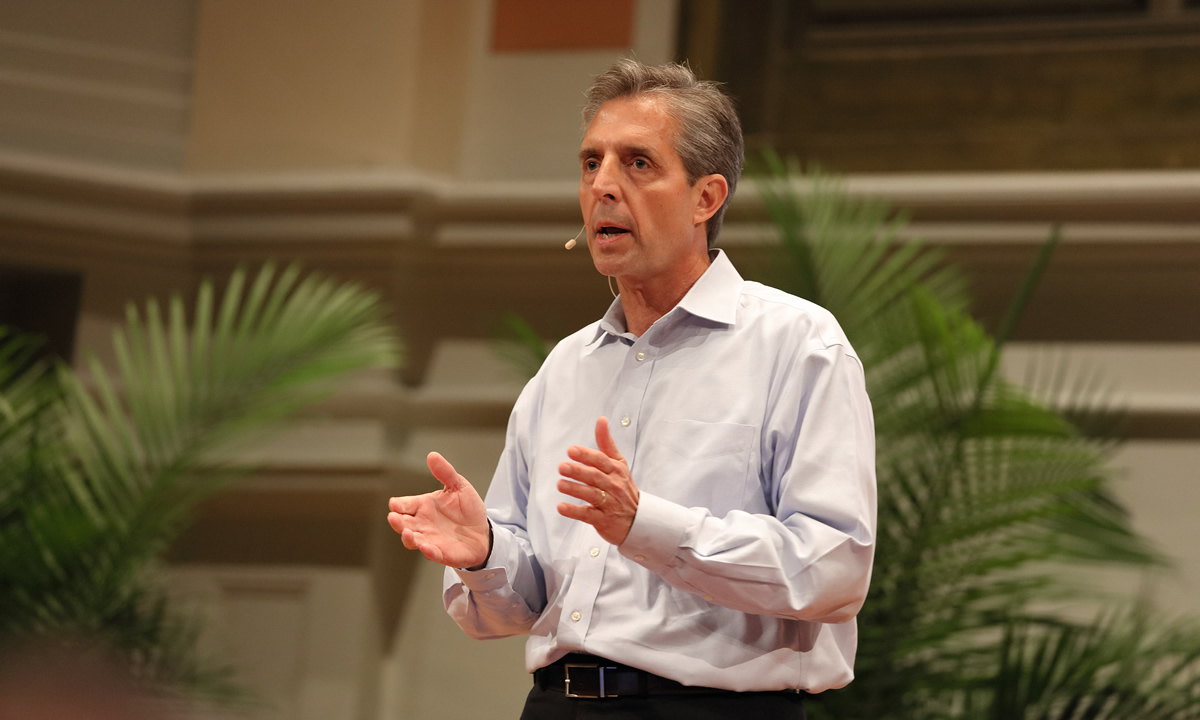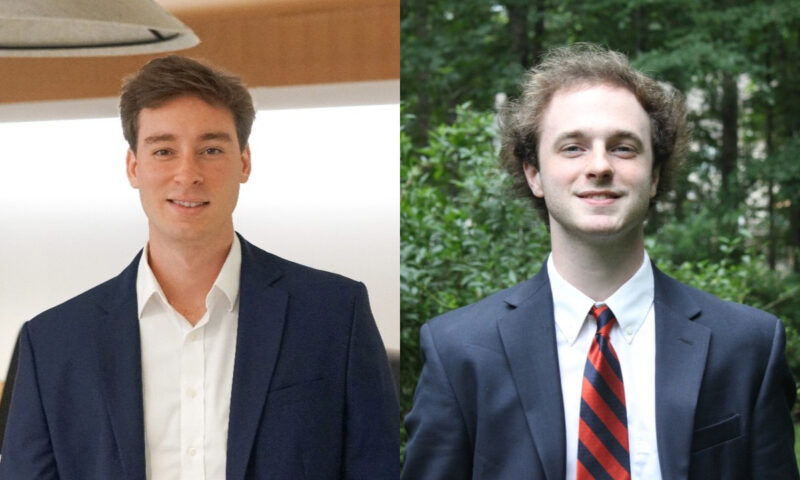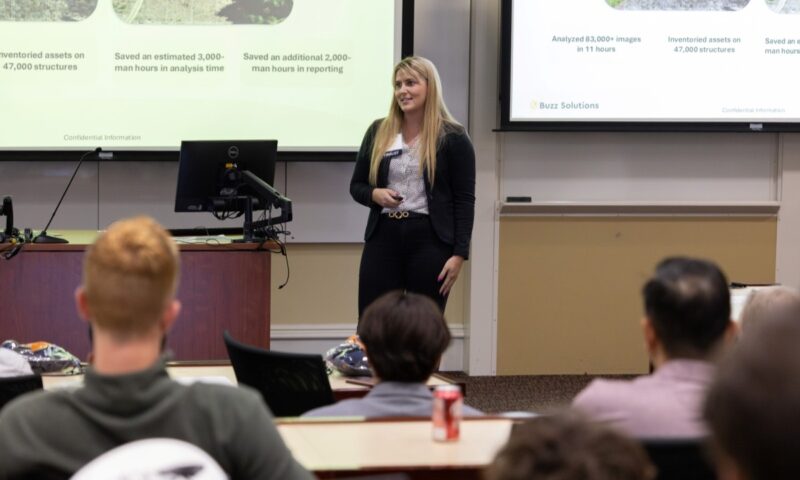
As the McIntire School of Commerce celebrates its Centennial in 2021, another important milestone is upon us: The School’s Center for the Management of Information Technology (CMIT) is now in its 30th successful year of fostering and sharing IT knowledge discovery through its cutting-edge events and programs.
McIntire’s Murray Research Professor and Center founder and Director Ryan Nelson says that the greatest accomplishments throughout the Center’s 30-year history are those that embody its core tenants: research, education, collaboration, and engagement. Having developed well over 100 programs that have impacted thousands of participants from a multitude of private and public sector organizations, the Center has also facilitated an active network of practitioners, faculty, and alumni, with the latter group representing a large number of engaged alumni from the M.S. in the Management of IT (M.S. in MIT) Program.
Nelson is proud that CMIT played host to the annual Center Directors meeting, welcoming dozens of centers from around the world, which he trusts was another step toward building the brand and reputation of both the Commerce School and UVA; these strides are further exemplified by the Center’s ability to develop an endowment totaling approximately $1 million, as well as the hiring of Amanda Morris as the Center’s first Associate Director of Strategic Initiatives and Operations.
Yet since the very beginning, Nelson says that the mission guiding CMIT has been, first and foremost, to produce opportunities for business and higher education to work together on vital issues impacting IT and its related topics. By all accounts, he has succeeded in realizing his concept—and then some.

Barb Wixom
Loyal Colleagues Meet Early Challenges
“Ryan had incredible vision for CMIT from the outset, and he married that with a tremendous passion that was infectious,” says former Commerce School faculty member Barb Wixom (A&S ’91), who served as Program Director for the Northern Virginia section of the M.S. in MIT Program for six years. “Ryan established a culture of curiosity, fun, and respect for contemporary thinking,” she says, recalling how faculty, students, and business leaders alike enjoyed CMIT events and lifelong learning programming.
Developing that unique culture required Nelson’s resourcefulness. He notes that upon launching in 1991, one of the most daunting challenges CMIT faced was ensuring that it would remain viable and self-funding.
Though he was inspired to see his concept for the Center become a reality, Nelson credits the assistance of others such as former Commerce School Dean Bill Shenkir and Professor Bob Trent with securing its official formation. “Bill was instrumental in helping create CMIT, shepherding our proposal through the Commonwealth of Virginia’s approval process, while Bob introduced me to a tremendous network of McIntire friends, alumni, and partner organizations.”
Other central Center collaborators in its early days were the initial “Associate Firms,” a group of industry partners keen to be involved in the intrepid plans Nelson had been preparing for CMIT. “They included Andersen Consulting (now Accenture), Best Products, Dominion Energy, DuPont, the IRS, NASA, and Sprint,” he says, listing the impressive and wide range of organizations.
Additionally, Nelson recognizes his former colleague for her contributions to the Center: “One key faculty member who helped establish CMIT was Barb Wixom.”
Wixom, who has been a guest speaker at Center events throughout the years and now serves as the Principal Research Scientist for MIT Sloan’s Center for Information Systems Research (CISR), isn’t quite so sure.
“I laugh that Ryan said I played a role in CMIT formation; that was all Ryan. I was more of a benefactor. I benefited from CMIT in about a million ways—including research funding, research contacts for cases and surveys, classroom speakers, student mentors, professional development, events for M.S. in MIT grad students, academic and professional networking, and on and on!” she says, noting that many relationships originating at CMIT events afforded her the chance to later invite IT leaders into her classroom, as well as inform her research.
Those first CMIT events illustrated direct connections to the research interests of McIntire faculty members, with some of those early programs including “IT and the Management of Change,” “Reinventing the IS/IT Organization,” and “IT and the Productivity Paradox.” The tradition of choosing event topics relevant to Commerce School faculty research continues today, represented in program subjects such as digital transformation and innovation, project and product management, artificial intelligence, machine learning, blockchain, cybersecurity, and organizational resilience.
But the Center’s events have never been solely inward-facing affairs. “A key objective has always been to promote interdisciplinary programs of research and education by leveraging faculty from across the McIntire School and UVA,” Nelson says, referencing the Schools of Engineering, Medicine, and College of Arts & Sciences as examples.
Eventful Steps
Beginning with the “Information Technology and Change Management” symposium in the fall of 1992, CMIT hosted a robust schedule of events focused on pertinent IT subjects with remarkable regularity. Panels, workshops, and symposia were held nearly every quarter for nearly 25 years, with some years boasting at least five such larger-scale meetings.
For Nelson, two events from CMIT’s first decade that were particularly notable: “Monticello Memoirs” and “The E-Summit.”
The former event, which took place in May of 1996, featured Gordon Moore, Intel Co-Founder and CEO (1975-1987), who discussed innovation in Silicon Valley and the impact of its location on its status in IT. “Monticello Memoirs” featured internationally renowned author, speaker, and consultant James Martin; his future-facing talk examined “Information Technology and the 21st Century Corporation.”
In November of 1999, the E-Summit welcomed 33 internet pioneers to Grounds for panels with prominent industry figures such as Shelby Bonnie (McIntire ’86), CNET Co-Founder and Vice Chairman (1993-2000), and Timothy Koogle, CEO of Yahoo (1995-2001); the public conference was part of a larger University initiative aimed at preparing for technological readiness by the still far-off date of 2020.
As CMIT entered the next century, Nelson continued to organize events delving into pressing IT issues and showing the increasing strength of its network, made evident by the many guest speakers who were excelling at the front lines of tech transformation.
One such event occurred in March of 2004: “Enterprise Systems Integration,” which examined the challenges of integrating information systems both within and across enterprises. The morning session featured a presentation by a CIO responsible for one the largest public and private sector such initiatives ever attempted: Steve Cooper, who was representing the then-nascent Department of Homeland Security.
Cooper, who had also formerly served as CIO for the Department of Commerce, FAA, and Red Cross, recalls his speaking engagement, detailing “people, process, technology, and governance, because governance oftentimes is the factor that actually makes or breaks major transformational initiatives.” The experience was of great interest to the attendees, who didn’t hide their curiosity about the newest arm of the federal government, and short of ducking audience questions on classified information, he was glad to have been a part of the event. As a result, he would return to numerous events over the years.
Considering Nelson both a professional colleague and friend, Cooper unreservedly credits the CMIT Director with having the vision to elevate CMIT and fulfill its mission to provide events of real value.
“Ryan’s a strategic and visionary thinker, but he is also very good at taking that strategy into action so that he can actually guide and execute from a leadership role,” the longtime Executive on Grounds in the M.S. in MIT Program says. “He takes big ideas and actually makes them real. Ryan has patience and perseverance, and he is also very open to input. That’s a huge contributing factor to his leadership style; I would call him a servant leader. He is a very talented, bright guy, but his ego isn’t huge—that makes a big difference because people participate at his request.”
The Knowledge Continuum Emerges
By 2008, CMIT was coalescing its extensive professional and alumni network connections and years of successful programming to launch a new event: the Knowledge Continuum, geared toward providing M.S. in MIT graduates-turned-IT-business leaders with a continuation of their academic learning experience.

Stefano Grazioli
Its premier edition in November of 2008 focused on core areas of strategy, architecture, project, and enterprise management, while examining new approaches to leadership, innovation, emerging technologies, and business intelligence. Case studies, research reports, exercises, interactive classroom discussions, and networking among the participants contributed to hours of the latest advances to emerge from the crossroads of IT and business.
“Year after year, our alumni come back to get a ‘booster shot’ of knowledge from my colleague Professor Stefano Grazioli!” Nelson adds.
As the ambitious educational event shifted to the spring while continuing to develop and refine its schedule, it not only shaped the Center’s ability to better connect with alumni, but also changed how it served its corporate partners.
“For 25 years, CMIT’s business model was based on an annual membership that allowed Associate Firms to send up to three people to four quarterly programs in Charlottesville, Richmond, or Washington, D.C.,” Nelson explains. “During the last five years, the model shifted to individual-enrollment programs known as the Knowledge Continuum.”

Theresa Payton
He believes that the event has come to define the Center and what it does best, pointing to installments like the 2015 edition, which saw another appearance by Cooper on the evolution of the role of the CIO, as well as talks from noteworthy speakers and authors who would become return guests in 2020 for virtual keynote conversations replacing the pandemic-impacted Knowledge Continuum event: Fortalice Solutions President and CEO Theresa Payton (M.S. in MIS ’90) and Founding Partner of Silicon Valley Product Group (SVPG) Marty Cagan.
A webinar in February of 2021 provided crucial insight into the cyber landscape—a virtual event that Nelson says has been one of the highlights of the Center: CMIT Associate Director Professor Ryan Wright held a conversation with New York Times’s Chief Washington Correspondent David Sanger, discussing the journalist’s landmark book, The Perfect Weapon: War, Sabotage and Fear in the Cyber Age.

Ryan Wright
In its continuing progress, the Knowledge Continuum has recently transformed yet again. For 2021, the event has become a yearlong executive education series of four quarterly events limited to 50 participants. The exclusivity is intentional: The design facilitates a more engaging level of interaction and ample networking. Each features a conversation with an expert or author and moderated by McIntire IT faculty, followed by discussions.
The year’s final event, anticipated for the fall of 2021, will invite participants to Grounds for a fitting celebratory reception to celebrate CMIT’s 30th anniversary.
Continuing the Mission
In addition to those who played important roles in promoting the Center at its start, Nelson recognizes the input and support of his IT faculty colleagues, designated as CMIT Scholars, as well as two individuals who would become CMIT Fellows and help define the Center as it became further established: Dan Elron, Managing Partner, Corporate Strategy, Innovation, and Technology at Accenture, and Chris Porter (A&S ’98, M.S. in MIT ’10), Chief Information Security Officer of Fannie Mae and an instructor in McIntire’s Cybersecurity Certificate Program.
“As a Fellow, Dan has helped advance CMIT’s mission for approximately a dozen years,” says Nelson, also mentioning Elron’s former, now-retired colleague from Accenture, McIntire Foundation Board member James “Jimmy” Harris (McIntire ’80), who he says helped initiate CMIT at the very beginning.

Dan Elron
Elron, an Executive on Grounds and an instructor for McIntire’s Digital Innovation and Digital Safari courses, became involved after moving to Charlottesville in 2005. He says that under Nelson’s leadership, the Center has become invaluable in its ability to connect “leading research and education with the practical needs of industry and government. CMIT has been fulfilling the need to translate new concepts and approaches into guidance for executives while providing a forum for practitioners to share experiences and also inform faculty about the realities of management in an environment where technology innovation is growing exponentially.”
For Porter, the intersection of academia and real-world practice keeps CMIT events fresh and extremely worthwhile. “I always feel that I learn something new at the event that I can take back to work the following week,” he says.
He notes that Nelson’s approach to inform Center’s events by learning directly from those who regularly attend them has made all the difference in their continued excellence. “Ryan is constantly taking the pulse of the IT community to understand what challenges we’re facing, then bringing in world-class speakers who help us, the practitioners, create strategies to solve those problems.”
Spurred to continue helping his industry colleagues meet those challenges, Nelson released an updated version of his e-book at the start of 2021. IT Project Management: Lessons Learned from Project Retrospectives 1999-2020, a type of “meta-retrospective” detailing 264 IT projects, offers guidance on leveraging best practices while avoiding IT projects mistakes. The volume is a testament to his decades of active research and desire to share actionable recommendations to help others achieve project success.
You might say that the e-book encapsulates the long-term goals for both Nelson and the Center.
Because as he looks forward, he remains sure that CMIT will continue to offer “a growing value proposition to an expanding set of constituencies,” noting the world-class faculty and top-notch facilities at McIntire and the University. He also cites new innovations inspired by sudden changes generated in early 2020, when the pandemic hit. Ultimately, for the Center, the unprecedented changes to all of our lives brought about some unexpectedly fortuitous outcomes, such as the ability to host international webinars, research briefings, and a newly realized cohort of patrons.
“Despite all of our accomplishments over the past 30 years, my hope is that CMIT’s greatest days lie ahead,” Nelson says.
It’s a reasonable assumption: Three extraordinary decades hosting hundreds of successful programs and thousands of attendees can’t be wrong.


